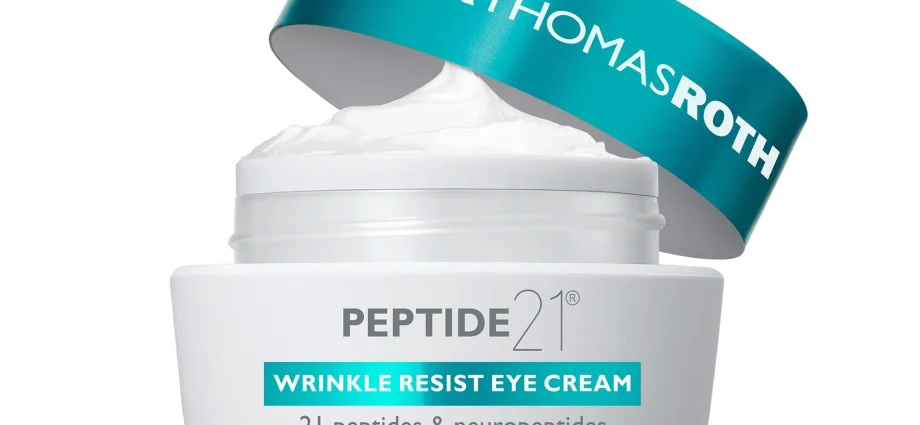Contents
- What are peptides
- Useful features and functions
- Types of creams with peptides
- Review of creams with peptides
- Soothing care for sensitive and allergy-prone skin Toleriane Ultra, La Roche-Posay
- Anti-Wrinkle Eye Concentrate with Vitamin C, Kiehl’s
- Night care “Age expert 45+”, L’Oréal Paris
- Anti-aging care for normal and combination skin Redermic C, La Roche-Posay
- Night cream for intensive recovery with a lifting effect Rénergie Multi-Lift, Lancôme
- Cream for redness-prone skin, Redness Neutralizer, SkinCeuticals
Both experts and ordinary users call products with peptides the cosmetics of the future. And there really is every reason for this.
What are peptides
Peptides are short chains of amino acids. That is, essentially the same proteins (proteins), consisting of 2 or more amino acids with smaller molecules. In turn, amino acids are the main building material of all tissues of the human body, including our skin.
Collagen and elastin are also proteins, so peptides interact with them quite easily. By the way, many hormones, as well as neurotransmitters (for example, the well-known endorphin) are peptides.
Useful features and functions
Vichy medical expert Ekaterina Turubara lists peptides as one of the most powerful innovative cosmetic ingredients. What is the reason for their effectiveness?
The size. Since peptide molecules are much smaller than protein molecules, they penetrate the stratum corneum more easily.
Relatedness. Peptides are easily integrated into cellular processes.
A wide range of actions. Dozens of types of peptides are used in cosmetics, which play the role of signal molecules and transmit a variety of “instructions” to skin cells, for example, to synthesize collagen or stop melanin production.
Stimulation of the skin’s own resources. The most natural impact determines the optimal result.
Non-toxic. Peptides break down rather quickly and do not accumulate in the body. However, this property is both a plus and a minus: there is a risk that, with certain individual characteristics, the peptide simply will not have time to reach the target cell.
All of the listed properties of peptides, their metabolic activity, were first used in preparations for cosmetic procedures, and then in anti-aging cosmetics.
Peptides are used in a wide variety of cosmetic formulas.
They are also included in the formulas for intensive care products for various skin problems, in the composition of conventional care products (which immediately makes them not quite ordinary), and even decorative cosmetics.
Here’s what peptide creams can do:
stimulate at the cellular level, the process of skin regeneration is the division of fibroblasts, young cells;
loosen skin reactivity, reduce inflammation;
activate the production of collagen and elastin, restoring a healthy skin tone and tightening the contours of the face;
suppress melanin synthesis, which minimizes hyperpigmentation and prevents it;
improve microcirculation in capillaries, which optimizes cell nutrition, returns a healthy complexion;
reduce the activity of facial muscles, affecting the nerve endings – unlike Botox, peptides do not block muscles. That is, mobility is preserved, and mimic wrinkles are smoothed out.
regulate the work of the sebaceous glands and thus fight acne.
There are still many wonderful discoveries ahead.
Types of creams with peptides
Since the range of action of peptides is very wide, they have become active ingredients in a wide variety of creams:
anti-aging;
for dry and sensitive, allergy-prone skin;
for oily and problem skin;
to care for the area around the eyes.
Accordingly, a cream with peptides is chosen depending on the problem to be solved.
Creams with peptides are capable of many things.
Since there are so many peptides used in cosmetics, it is difficult to list them all. In addition, most names are difficult to remember without special training. Here are the most common:
Argireline;
haloxyl;
neurosensin;
retinopeptide;
all possible derivatives of the word “peptide”: tetrapeptide, pentapeptide, hexapeptide, oligopeptide.
Review of creams with peptides
In our review, you will find products with peptides for different skin types.
Soothing care for sensitive and allergy-prone skin Toleriane Ultra, La Roche-Posay
Includes neurosensin peptide, which has a pronounced calming effect. Makes the skin less reactive, more resistant to external and internal negative factors. Used as a regular daytime moisturizer.
Read more about skin protection during allergy season here.
Anti-Wrinkle Eye Concentrate with Vitamin C, Kiehl’s
In addition to pure vitamin C, it contains a tripeptide and tetrapeptide complex to strengthen the skin of the eyelids and reduce the intensity of dark circles. Read more about this product in this article.
Night care “Age expert 45+”, L’Oréal Paris
It combines caring ingredients such as provitamin A, known for its antioxidant properties, with innovative retinopeptides in its formula, which accelerate the recovery and regeneration of the skin.
Anti-aging care for normal and combination skin Redermic C, La Roche-Posay
It has a powerful antioxidant effect due to the high content of vitamin C. Due to the action of mannose and hyaluronic acid, it slows down the aging process. The composition also contains a restorative madecasosside and an anti-stress peptide neurosensin.
Night cream for intensive recovery with a lifting effect Rénergie Multi-Lift, Lancôme
In addition to valuable plant extracts, hyaluronic acid and the “energy” of adenosine, it contains a complex of oligopeptides. They contribute to the production of 10 proteins that bind the layers of the skin and determine its elasticity, start the process of rejuvenation. As a result, the texture of the skin improves, it becomes soft and radiant.
Cream for redness-prone skin, Redness Neutralizer, SkinCeuticals
The cream is formulated with the powerful NeuroMed peptide, which is known for its ability to act on the inflammatory cascade in the skin and reduce redness. Also, the product moisturizes the skin, gives radiance.










